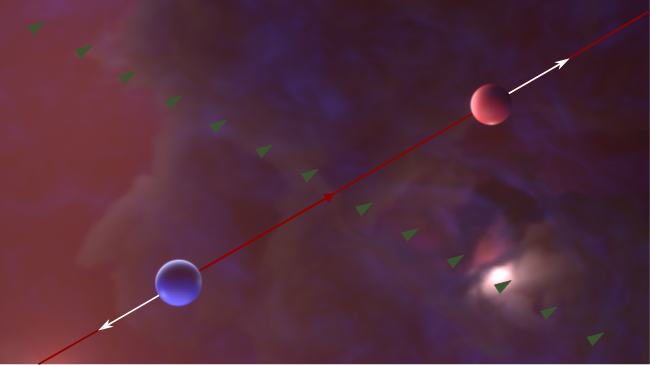A Holographic View into Quantum Anomalies
New calculations provide insights into the dynamics of the chiral magnetic effect in heavy ion collisions.

The Science
Theorists calculated how the key ingredients of a phenomenon called the chiral magnetic effect (CME) should evolve over time in an expanding quark-gluon plasma (QGP). QGP is a soup of quarks and gluons (the building blocks of protons and neutrons) that existed in the early universe. High energy heavy ion collisions recreate this primordial matter and also generate powerful magnetic fields. The theorists used the holographic principle—a type of mathematical correspondence between theories—to model the magnetic fields and other characteristics needed for the CME at different collision energies. The results will help scientists interpret collision data and plan new searches for the CME.The Impact
The chiral magnetic effect is triggered by an imbalance in the number of right- and left-handed particles. A particle’s handedness, or chirality, is determined by whether its spin is aligned with or opposite its momentum. Understanding this phenomenon might help scientists learn about other imbalances in nature, such as the imbalance between matter and antimatter in our universe. Scientists are attempting to measure the CME in heavy ion collisions. This would offer a rare laboratory-based opportunity to observe the quantum anomaly underlying this long-sought physics phenomenon. This work provides a theoretical description of the conditions these scientists should explore to search for the CME.Summary
Chirality describes a particle’s “handedness.” Right-handed particles have spin axes aligned with their momentum, or direction of motion; left-handed particles’ spin axes point opposite their momentum. In high energy heavy ion collisions, quantum mechanical effects can flip some particles’ momentum while maintaining their spin to trigger a chiral imbalance. That imbalance leads to the separation of differently charged particles, causing a powerful electric current to flow along the magnetic field generated in these collisions. New calculations by researchers at Brookhaven National Laboratory and the University of Alabama compute the time dependence of this “chiral magnetic effect” (CME) in heavy ion collisions.
The calculations take advantage of a holographic correspondence between theories that allows scientists to perform otherwise prohibitively complex calculations of quantum chromodynamics (QCD), the theory that describes the behavior of matter generated in heavy ion collisions. The theorists begin by approximating QCD with a closely related theory. This theory has a corresponding theory of gravity in higher dimensions where the theorists perform their calculations. That simplifies the process significantly compared to the original theory. The calculations show how the time dependence of the main ingredients of the CME (magnetic field strength, chiral imbalance, collision energy) affect the current generated in heavy ion collisions.
Contact
Bjoern Schenke
Brookhaven National Laboratory
bschenke@bnl.gov
Matthias Kaminski
University of Alabama
mski@ua.edu
Funding
This research was funded by the Department of Energy Office of Science, Office of Nuclear Physics, and the Office of Science Graduate Student Research (SCGSR) program.Publications
Cartwright, C., Kaminski, M., and Schenke, B., Energy dependence of the chiral magnetic effect in expanding holographic plasma, Physical Review C 105 034903 (2022). [DOI: 10.1103/PhysRevC.105.034903 ]Highlight Categories
Program: NP
Performer: DOE Laboratory



